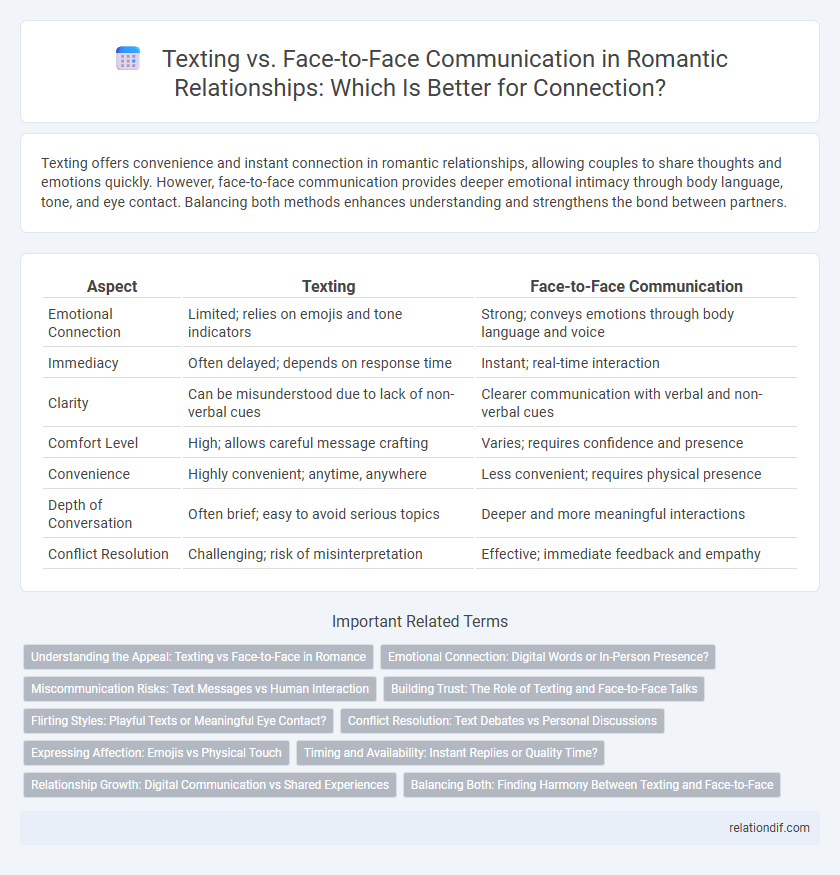Texting offers convenience and instant connection in romantic relationships, allowing couples to share thoughts and emotions quickly. However, face-to-face communication provides deeper emotional intimacy through body language, tone, and eye contact. Balancing both methods enhances understanding and strengthens the bond between partners.
Table of Comparison
| Aspect | Texting | Face-to-Face Communication |
|---|---|---|
| Emotional Connection | Limited; relies on emojis and tone indicators | Strong; conveys emotions through body language and voice |
| Immediacy | Often delayed; depends on response time | Instant; real-time interaction |
| Clarity | Can be misunderstood due to lack of non-verbal cues | Clearer communication with verbal and non-verbal cues |
| Comfort Level | High; allows careful message crafting | Varies; requires confidence and presence |
| Convenience | Highly convenient; anytime, anywhere | Less convenient; requires physical presence |
| Depth of Conversation | Often brief; easy to avoid serious topics | Deeper and more meaningful interactions |
| Conflict Resolution | Challenging; risk of misinterpretation | Effective; immediate feedback and empathy |
Understanding the Appeal: Texting vs Face-to-Face in Romance
Texting in romance offers convenience and instant emotional expression, allowing couples to maintain connection despite busy schedules or distance. Face-to-face communication provides deeper emotional intimacy through nonverbal cues like facial expressions, tone, and body language, essential for building trust. Balancing both methods enriches romantic relationships by combining immediacy with profound personal interaction.
Emotional Connection: Digital Words or In-Person Presence?
Texting allows couples to share immediate thoughts and maintain constant contact, yet it often lacks the depth of emotional nuance conveyed through facial expressions and tone in face-to-face communication. In-person presence enhances emotional connection by enabling nonverbal cues like eye contact, touch, and body language, which foster intimacy and empathy. While digital words create convenience, the richness of emotional bonding thrives most powerfully in shared physical environments.
Miscommunication Risks: Text Messages vs Human Interaction
Texting lacks vocal tone and facial expressions, increasing the risk of misinterpretation in romantic conversations. Human interaction allows partners to pick up on subtle emotional cues, reducing misunderstandings. Miscommunication through text can lead to unnecessary conflicts that in-person communication often prevents.
Building Trust: The Role of Texting and Face-to-Face Talks
Face-to-face communication fosters trust through nonverbal cues like eye contact, tone, and body language, which create emotional connection and authenticity in romantic relationships. Texting allows for frequent, immediate exchanges that maintain a sense of closeness, but lacks the depth of in-person interactions necessary for building deeper trust. Balancing texting with meaningful face-to-face talks strengthens trust by combining convenience with genuine emotional engagement.
Flirting Styles: Playful Texts or Meaningful Eye Contact?
Playful texts allow romantic partners to express wit and charm through emojis and clever wordplay, fostering a lighthearted and engaging connection that keeps attraction alive. Meaningful eye contact in face-to-face interactions deepens emotional intimacy by conveying sincerity and vulnerability, enhancing the nonverbal flirtation essential for building trust. Understanding individual preferences for digital playfulness or in-person connection can optimize romantic communication strategies and strengthen relationship bonds.
Conflict Resolution: Text Debates vs Personal Discussions
Text debates often escalate misunderstandings in romantic conflicts due to lack of vocal tone and body language cues, which are vital for emotional clarity and empathy. Personal discussions enable partners to express feelings more effectively and resolve disputes with immediate feedback and nuanced communication. Face-to-face interaction supports trust-building and quicker reconciliation compared to the delayed and sometimes misinterpreted responses typical in texting.
Expressing Affection: Emojis vs Physical Touch
Texting allows the use of emojis to quickly convey affection, capturing emotions through visual symbols that can enhance verbal messages. Physical touch in face-to-face communication, such as holding hands or hugging, provides a tangible connection that deepens emotional intimacy and trust. While emojis offer a playful and immediate expression of feelings, physical touch delivers a powerful, nonverbal affirmation that strengthens romantic bonds.
Timing and Availability: Instant Replies or Quality Time?
Timing and availability are crucial in romantic communication, with texting offering instant replies that maintain engagement but can disrupt quality moments. Face-to-face communication prioritizes undivided attention, fostering deeper emotional connections without digital distractions. Balancing timely responsiveness with meaningful presence enhances relationship satisfaction and trust.
Relationship Growth: Digital Communication vs Shared Experiences
Digital communication offers couples instant connection through texting, fostering constant engagement that can build emotional intimacy over time. However, face-to-face interactions provide richer shared experiences, enabling deeper understanding through nonverbal cues, tone, and physical presence that strengthen relationship bonds. Combining frequent texting with meaningful in-person moments accelerates relationship growth by balancing emotional closeness and authentic connection.
Balancing Both: Finding Harmony Between Texting and Face-to-Face
Balancing texting and face-to-face communication in romance involves recognizing the strengths of each medium to enhance connection and intimacy. Texting allows for immediate, thoughtful exchanges and maintaining daily contact, while face-to-face interactions foster deeper emotional bonds through nonverbal cues and authentic presence. Prioritizing clear intentions and quality time in both formats creates a harmonious relationship dynamic that supports trust and understanding.
texting vs face-to-face communication Infographic

 relationdif.com
relationdif.com